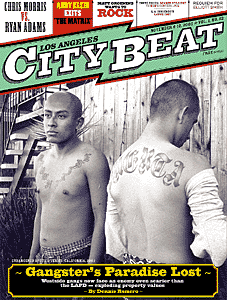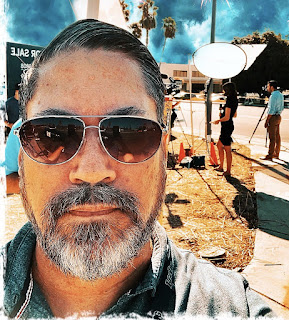California boomin'
 John Tejada Rides the Wave of L.A.'s Techno Renaissance
John Tejada Rides the Wave of L.A.'s Techno RenaissanceBy Dennis Romero
Wednesday, July 23, 2008
John Tejada landed in Los Angeles in the early 1980s at the age of 8. His mother, a Mexican-American opera singer, had left his Austrian father and settled in Panorama City. After a Viennese childhood of piano lessons, touring opera houses with his parents and exposure to the best classical music, the grade-schooler woke up one day in the northeast Valley hoping he wouldn’t get shot on the way to school, hoping that a nerdlike devotion to the sounds of “techno-hop” and true-school electro would keep him under the local gangs’ radar. And so, little John listened on his Walkman as the earth seemed to quake, pop and break-dance to the robotic sounds of the Unknown DJ, Egyptian Lover, Arabian Prince, Afrika Bambaataa and Arthur Baker.
“All these electronic genres came out of these urban environments,” says the techno producer, now 34. “House, techno and drum ’n’ bass all came out of poor environments where people really wanted to express themselves, just like with jazz and blues.”
Today, a new generation has descended on electronic dance music, giving fresh life to a very different kind of electro — a term dubiously bestowed on the likes of Daft Punk, Justice and Simian Mobile Disco. Tejada, sitting in his home studio in Sherman Oaks, chuckles at the nomenclature. “That’s not electro. Slap on something from ’83 — that’s electro. That’s my biggest influence, that early electronic craziness.”
Some of those same nu-electro kids, however, are also digging deeper into the sounds of techno, a close relative of electro that happens to be Tejada’s forte at a fortunate time. There’s been a techno renaissance in L.A., represented by the Droid Behavior crew’s underground parties, promoter Compression’s regular club nights, a techno-heavy booking schedule at Avalon Hollywood on Saturdays, and a new crop of DJs, such as the minimalist trio known as Droog. The city is also plugging into a global wave of boom-tss technology from Detroit (Osborne), Berlin (Ellen Allien), Denmark (Trentemøller), Tijuana (Bostich+Fussible) and even São Paulo (Gui Boratto).
L.A.’s own techno torchbearer is Tejada, who’s been working in the trenches of the Detroit-born genre since the early ’90s, when he enjoyed more success in his native Europe than in L.A. “It was a really lonely ’90s, to get that initial interest in pretty much everywhere else in the globe but home,” he says.
That has changed in the past few years, however, as the city has taken to the “minimal” movement, and Tejada stepped up to feed the need in 2004 with well-received productions, including “Sweat (On the Walls).” Tejada has since deejayed at Avalon and is the resident spinner for Compression’s club nights. Now he’s put an exclamation point on his hometown coronation with a new album that rivals the quality of anything put out on tastemaker techno labels such as Kompakt, Poker Flat or Ghostly International: Where is out this month as the 50th release on Tejada’s own Palette Recordings label.
The album has Tejada in a fully accessible mode, pumping out highly contemporary grooves that bubble, shuffle and boom, seemingly with superclub rooms in mind. Bass is sometimes off the Richter scale (“Feel It”), acidlike synths boil underfoot like Botts’ dots on an open highway (“La Mer”), and throughout the album, there’s a sense of head-bobbing seriousness (“Moogbits”) that would give the Sopranos a chill. If there is an infestation of economic and diplomatic doom in the world, Where rounds it up and stomps on it with glee.
Yet, as brooding as Tejada’s album can feel, it opens up at times, letting in light, chi and gentle keys (“Raindrops”). Where gets downright chart-happy with “Desire,” an icy come-on that builds skyward like an Arab tycoon in Dubai. Vocalist Nicolette, a relative newcomer to electronic dance music, puts it down in jazzy fashion as the track finally kicks in the door with SWAT-like efficiency.
For all its tech-savvy flavor, it’s surprising to learn that Where was made mostly with analog gear, including knob-driven synths and rubbery drum machines out of the Dark Ages. There’s nary a sample, software patch or laptop groove in sight. Tejada took his classical background and musical skills, including drum playing, and built Where from the kicks up. “To me, the album conveys a more simple idea, even though it’s rich in layers,” Tejada says. “In that way, I do feel my music does have that spirit of being influenced by my mother. With this album, I was just trying to have a bigger voice, experimenting with new ideas, trying to be as honest as possible.”
Tejada is 6 feet 1 inch tall, and has wavy dark hair and a cherubic face that can barely contain his teeth. His ideal gig has him twisting some synth knobs and finger-drumming on pads for a few well-behaved friends at an art gallery. Perhaps that’s the future. He and his longtime girlfriend, Green Galactic PR founder Lynn Hasty, have put on experimental electronic events since the mid-’90s. The events were often more wine-sipping than e-dropping. Her cerebral “Twine” laptop-DJ performances at the Knitting Factory were ahead of their time. When you look back, the events seem to reflect artistic innocence. Today’s superclub scene is sometimes repulsive to Tejada. “It seems like the bigger interest is to get high and party,” he says, “and the music comes second.”
Tejada’s red-trim-on-white ranch home is a sanctuary, and his studio inside, while imposing and complex, is old-school to the bone, featuring odd-named gear, such as a Poly-Box filter, Jomox XBase 999 step sequencer and a Vermona synthesizer. It’s all very hands-on and DIY for an age in which software programs such as Ableton Live or Propellerhead Reason can do it all within the confines of a laptop. Overlooking the racks of knobs and massive 10-inch studio monitors is a poster of Kraftwerk’s Computer World, circa 1981. It’s all coming back — techno, electro and a collision of classical sensibilities and ghetto rhythms.
One of the things that’s cool about Where, too, is that it’s an Angeleno homecoming for a genre that has been taken over by overseas producers and DJs. Longtime Tejada collaborator Arian Leviste contributed in the studio. And British transplant Nicolette penned the lyrics to her track. To date, Where is shaping up to be L.A.’s most solid contribution to global techno.
“The goal for me is to always kind of unplug and get back to that original feeling,” Tejada says. “But I wouldn’t mind stepping out of the underground at all.”



Comments